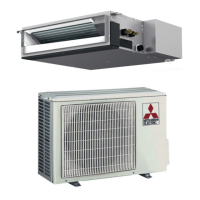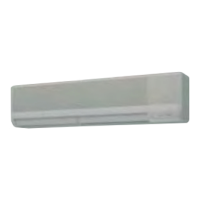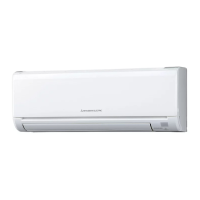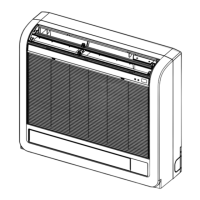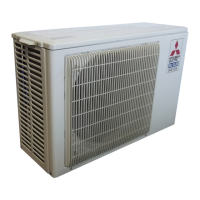2
Contents
Warning:
• Do not install it by yourself (customer).
Incomplete installation could cause injury due to fire, electric shock,
the unit falling or leakage of water. Consult the dealer from whom you
purchased the unit or special installer.
• This appliance is not intended for use by persons (including children) with
reduced physical, sensory or mental capabilities, or lack of experience
and knowledge, unless they have been given supervision or instruction
concerning use of the appliance by a person responsible for their safety.
• This appliance is intended to be used by expert or trained users in shops,
in light industry and on farms, or for commercial use by lay persons.
•
Install the unit securely in a place which can bear the weight of the unit.
When installed in an insucient strong place, the unit could fall causing injured.
• Use the specied wires to connect the indoor and outdoor units securely
and attach the wires rmly to the terminal board connecting sections so the
stress of the wires is not applied to the sections.
Incomplete connecting and xing could cause re.
• Do not use intermediate connection of the power cord or the extension
cord and do not connect many devices to one AC outlet.
It could cause a re or an electric shock due to defective contact, defective
insulation, exceeding the permissible current, etc.
•
Check that the refrigerant gas does not leak after installation has completed.
• Perform the installation securely referring to the installation manual.
Incomplete installation could cause a personal injury due to re, electric
shock, the unit falling or leakage of water.
• Perform electrical work according to the installation manual and be sure to
use an exclusive circuit.
If the capacity of the power circuit is insufficient or there is incomplete
electrical work, it could result in a re or an electric shock.
• If the supply cord is damaged, it must be replaced by the manufacturer, its
service agent or similarly qualied persons in order to avoid a hazard.
• Attach the electrical part cover to the indoor unit and the service panel to
the outdoor unit securely.
If the electrical part cover in the indoor unit and/or the service panel in the
outdoor unit are not attached securely, it could result in a re or an electric
shock due to dust, water, etc.
• Be sure to use the part provided or specied parts for the installation work.
The use of defective parts could cause an injury or leakage of water due to
a re, an electric shock, the unit falling, etc.
•
Ventilate the room if refrigerant leaks during operation.
If the refrigerant comes in contact with a ame, poisonous gases will be released.
•
Children should be supervised to ensure that they do not play with the appliance.
• The installer and system specialist shall secure safety against leakage
according to local regulation or standards.
- The instructions in this manual may be applicable if local regulation are not
available.
• Pay a special attention to the place, such as a basement, etc. where
refrigeration gas can stay, since refrigeration is heavier than the air.
• When installing, relocating, or servicing the air conditioner, use only the
specied refrigerant written on the outdoor unit to charge the refrigerant
lines. Do not mix the refrigerant with any other refrigerant, and do not allow
air to remain in the lines.
- If air is mixed with the refrigerant, then it may cause abnormal high pressure in
the refrigerant lines, resulting in an explosion and other hazards.
- The useof anyrefrigerant other thanthat speciedfor thesystem will cause
mechanical failure, system malfunction, or unit breakdown. In the worst case,
this could lead to a serious impediment to securing product safety.
- It may also be in violation of applicable laws.
-
MITSUBISHI ELECTRIC CORPORATION cannot be held responsible for
malfunctions or accidents resulting from the use of the wrong type of refrigerant.
• This indoor unit should be installed in a room which is equal to or larger
than the oor space specied in the outdoor unit installation manual. Refer
to the outdoor unit installation manual.
• Only use means recommended by the manufacturer to accelerate the
defrosting process or to clean.
•
This indoor unit shall be stored in a room that has no continuously-operating
ignition device such as open ame, gas appliance, or electrical heater.
• Do not pierce a hole in or burn this indoor unit or refrigerant lines.
• Be aware that the refrigerant may be odour-free.
• Pipe-work shall be protected from physical damage.
• The installation of pipe-work shall be kept to a minimum.
• Compliance with national gas regulations shall be observed.
• Keep any required ventilation openings clear of obstruction.
• Do not use low temperature solder alloy when brazing the refrigerant pipes.
•
When performing brazing work, be sure to ventilate the room sufficiently.
Make sure that there are no hazardous or ammable materials nearby. When
performing the work in a closed room, small room, or similar location, make
sure that there are no refrigerant leaks before performing the work. If refrigerant
leaks and accumulates, it may ignite or poisonous gases may be released.
Note: The phrase “Wired remote controller” in this installation manual refers only to the PAR-40MAA. If you need any information for the other remote controller, please
refer to either the installation manual or initial setting manual which are included with the remote controller.
1. Safety precautions
Before installing the unit, make sure you read all the “Safety Precautions”.
The “Safety Precautions” provide very important points regarding safety. Make sure you follow them.
Please report to or take consent by the supply authority before connection to the system.
MEANINGS OF SYMBOLS ON THE UNIT
WARNING
(Riskofre)
This symbol is only for R32 refrigerant. The type of the refrigerant used is written on the nameplate on the outdoor unit.
R32refrigerantisammable.Iftherefrigerantleaks,orcomesincontactwithreorpartsthatgenerateheat,itmaycreateharmfulgasand
poseariskofre.
Read the OPERATION MANUAL carefully before operation.
Service personnel are required to carefully read the OPERATION MANUAL and INSTALLATION MANUAL before operation.
Further information is available in the OPERATION MANUAL, INSTALLATION MANUAL, and the like.
• Please report to or take consent by the supply authority before connection
to the system.
• Be sure to read “Safety precautions” before installing the air conditioner.
• Be sure to observe the cautions specied here as they include important
items related to safety.
• The indications and meanings are as follows.
Warning:
Could lead to death, serious injury, etc.
Caution:
Could lead to serious injury in particular environments when operated
incorrectly.
• After reading this manual, be sure to keep it together with the instruction
manual in a handy place on the customer’s site.
Symbols put on the unit
: Indicates an action that must be avoided.
: Indicates that important instructions must be followed.
: Indicates a part which must be grounded.
: Indicates that caution should be taken with rotating parts.
:Indicatesthatthemainswitchmustbeturnedobeforeservicing.
: Beware of electric shock.
: Beware of hot surface.
Warning:
Carefully read the labels axed to the main unit.
1. Safety precautions .....................................................................................2
2. Selecting the installation location ..............................................................3
3. Selecting an installation site & Accessories .............................................. 3
4. Fixing hanging bolts ..................................................................................4
5. Installing the unit .......................................................................................5
6. Refrigerant piping work .............................................................................7
7. Duct work ..................................................................................................9
8. Electrical work ...........................................................................................9
9. Test run ....................................................................................................13
10. Maintenance ............................................................................................16
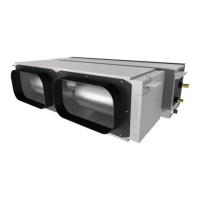
